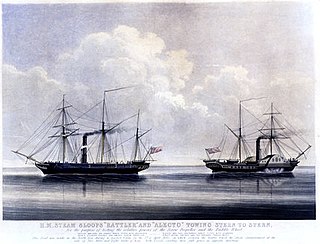Citations and references
Citations
- ↑ Phipps (1840), p. 158.
- ↑ Wadia (1986), p. 343.
- ↑ Hackman (2001), p. 333.
- 1 2 Colledge & Warlow (2006), p. 134.
- ↑ Low (1877), p. 583.
- ↑ Gibson-Hill (1954), p. 133, Fn#4.
Related Research Articles
Seven ships of the Royal Navy have been named HMS Prince of Wales, after numerous holders of the title the Prince of Wales.
Thirteen warships of the Royal Navy have been named HMS Revenge:

HMS Vanguard was a 90-gun second-rate ship of the line of the Royal Navy, built at Portsmouth Dockyard and launched in 1678.
Three vessels and two shore establishments of the Royal Navy have been named HMS Bee, after the insect, the bee. A third ship was ordered but never completed:
Nine ships of the Royal Navy have borne the name HMS Falmouth, after the town of Falmouth:

HMS Rattler was a 9-gun steam screw sloop of the Royal Navy, and one of the first British warship to be completed with screw propulsion. She was originally ordered as a paddle wheel 4-gun steam vessel from Sheerness Dockyard on 12 March 1841. She was reordered on 24 February 1842 as a propeller type 9-gun sloop from HM Royal Dockyard, Sheerness as a new vessel. Sir William Symonds had redesigned the ship as a screw propeller driven vessel.
Seven ships of the Royal Navy have borne the name HMS Hawke, after an archaic spelling of the bird, the hawk. Two of the later ships were named after Edward Hawke, 1st Baron Hawke, whilst another was planned:
Nine ships and one shore establishment of the Royal Navy have been named HMS Wasp, with one other government vessel using the name:

HMS Fisgard was a 46-gun fifth rate Leda-class frigate of the Royal Navy. She spent sixty years in service on a variety of duties.
Five ships of the Royal Navy have borne the name HMS Tigris, after the river Tigris, in modern-day Iraq. Another was planned but never completed:
Four ships of the Royal Navy have borne the name HMS Morning Star, after the poetic name for Venus:

The Conqueror-class ships of the line were a class of two 101-gun first rate screw propelled ships designed by the Surveyor’s Department for the Royal Navy.

The Seringapatam-class frigates, were a class of British Royal Navy 46-gun sailing frigates.
Five vessels of the Royal Navy have been named HMS Harlequin.
Four vessels with the name Hastings have served the East India Company (EIC), one on contract as an East Indiaman, one brig of the Bombay Pilot Service, one ship of the line, and one frigate of the Company's Bombay Marine.

HCS Coote was a sloop-of-war that served the British East India Company (EIC) during the 19th century. The Bombay Dockyard launched Coote in 1827. Though the EIC built Coote, her size and armament were equivalent to the retired Cruizer-class brig-sloops.
INS Ariadne was a flat-bottomed iron paddle steamer built in England in 1839 for the Indian Navy of the Bombay Government of the British East India Company. She was shipped to India in pieces and assembled at the Bombay Dockyard in 1840. She sailed from India to join the British fleet off Shanghai, China, during the First Opium War but was damaged and later foundered on 23 June 1842.
Several ships have been named Euphrates for the Euphrates River:
Several ships have been named Tigris for the Tigris River:
The H[onourable] C[ompany's] S[hip] Hugh Lindsay was a paddle steamer built in Bombay in 1829 for the naval arm of the British East India Company (EIC) and the first steamship to be built in Bombay. She pioneered the mail route between Suez and Bombay. Hugh Lindsay was lost in the Persian Gulf on 18 August 1865.
References
- Colledge, J. J.; Warlow, Ben (2006) [1969]. Ships of the Royal Navy: The Complete Record of all Fighting Ships of the Royal Navy (Rev. ed.). London: Chatham Publishing. ISBN 978-1-86176-281-8.
- Gibson-Hill, C.A. (1954). "The Steamers employed in Asian Waters, 1819-39". Journal of the Malayan Branch of the Royal Asiatic Society. 27 (1): 120–162.
- Hackman, Rowan (2001). Ships of the East India Company. Gravesend, Kent: World Ship Society. ISBN 0-905617-96-7.
- Low, Charles Rathbone (1877). History of the Indian Navy: (1613-1863). R. Bentley and son.
- Phipps, John (1840). A Collection of Papers Relative to Ship Building in India ...: Also a Register Comprehending All the Ships ... Built in India to the Present Time ... Scott.
- Wadia, R. A. (1986) [1957]. The Bombay Dockyard and the Wadia Master Builders. Bombay.